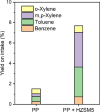Novel Staged Free-Fall Reactor for the (Catalytic) Pyrolysis of Lignocellulosic Biomass and Waste Plastics
- PMID: 38774064
- PMCID: PMC11103701
- DOI: 10.1021/acs.energyfuels.3c04733
Novel Staged Free-Fall Reactor for the (Catalytic) Pyrolysis of Lignocellulosic Biomass and Waste Plastics
Abstract
Pyrolysis of lignocellulosic biomass and waste plastics has been intensely studied in the last few decades to obtain renewable fuels and chemicals. Various pyrolysis devices have been developed for use in a laboratory setting, operated either in batch or continuously at scales ranging from milligrams per hour to tenths of g per hour. We report here the design and operation of a novel staged free-fall (catalytic) pyrolysis unit and demonstrate that the concept works very well for the (catalytic) pyrolysis of pinewood sawdust, paper sludge, and polypropylene as representative feeds. The unit consists of a vertical tube with a pretreatment section, a pyrolysis section, a solid residue collection section, a gas-liquid separation/collection section, and a catalytic reaction section to optionally perform ex situ catalytic upgrading of the pyrolysis vapor. The sample is placed in a tube, which is transported by gravity through various sections of the unit. It allows for rapid testing with semicontinuous feeding (e.g., 50 g h-1) and the opportunity to perform reactions under an (inert) gas (e.g., N2) at atmospheric as well as elevated pressure (e.g., 50 bar). Liquid yields for noncatalytic sawdust pyrolysis at optimized conditions (475 °C and atmospheric pressure) were 63 wt % on biomass intake. A lower yield of 51 wt % (on a biomass basis) was obtained for the noncatalytic pyrolysis of paper sludge, likely due to the presence of minerals (e.g., CaCO3) in the feed. The possibility of using the unit for ex situ catalytic pyrolysis (pyrolysis at 475 °C and catalytic upgrading at 550 °C) was also successfully demonstrated using paper sludge as the feed and H-ZSM-5 as the catalyst (21 wt % catalyst on biomass). This resulted in a biphasic liquid product with 25.6 wt % of an aqueous phase and 11 wt % of an oil phase. The yield of benzene, toluene, and xylenes was 1.9 wt % (on a biomass basis). Finally, the concept was also proven for a representative polyolefin (polypropylene), both noncatalytic as well as in situ catalytic pyrolysis using H-ZSM-5 as the catalyst at 500 °C. The liquid yield of thermal, noncatalytic plastic pyrolysis was as high as 77 wt % on plastic intake, while in situ catalytic pyrolysis gave a combined 7.8 wt % yield of benzene, toluene, and xylenes on plastic intake.
© 2024 The Authors. Published by American Chemical Society.
Conflict of interest statement
The authors declare no competing financial interest.
Figures







References
-
- Basu P.Biomass Gasification, Pyrolysis and Torrefaction (Practical Design and Theory); Academic Press, 2018.10.1016/C2016-0-04056-1. - DOI
-
- Afraz M.; Muhammad F.; Nisar J.; Shah A.; Munir S.; Ali G.; Ahmad A. Production of value added products from biomass waste by pyrolysis: An updated review. Waste Manage. Bull. 2024, 1 (4), 30–40. 10.1016/j.wmb.2023.08.004. - DOI
-
- Nanduri A.; Kulkarni S. S.; Mills P. L. Experimental techniques to gain mechanistic insight into fast pyrolysis of lignocellulosic biomass: A state-of-the-art review. Renewable Sustainable Energy Rev. 2021, 148, 111262.10.1016/j.rser.2021.111262. - DOI
-
- Campuzano F.; Brown R. C.; Martínez J. D. Auger reactors for pyrolysis of biomass and wastes. Renewable Sustainable Energy Rev. 2019, 102, 372–409. 10.1016/j.rser.2018.12.014. - DOI
-
- Bartolucci L.; Cordiner S.; Di Carlo A.; Gallifuoco A.; Mele P.; Mulone V. Platform chemicals recovery from spent coffee grounds aqueous-phase pyrolysis oil. Renewable Energy 2024, 220, 119630.10.1016/j.renene.2023.119630. - DOI
LinkOut - more resources
Full Text Sources
